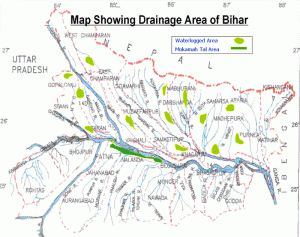
Drainage system and Rivers of Bihar: Bihar surface drainage except the districts of East Singhbum, West Singhbum and Most of Ranchi district goes to meet Ganga or its tributary ,Hooghly. The drainage of East Singhbum, West Singhbum and Most of Ranchi district is directly drained into Bay of Bengal through Sankh, South Koel and Suparnarekhariver.
Ganga
It is the major River of Bihar which divides Bihar into two parts. The river has its origin in the Western Himalayan Ranges in the state of Uttarakhand. The major tributaries of the Ganga are as follows:
Left tributaries – Karnali, Mahakhali, Gandak, Koshi (Kosi), Ghaghra, and Damodar
Right tributaries – Yamuna, Son, Mahananda, Chambal
Major tributaries of Ganga in Bihar are Gandak, Bagmati, Kosi, Kali and Sone.
The Ganga and its tributaries function as a perpetual source of water supply to a huge agricultural region in India. Major crops grown in the region include sugarcane, rice, oilseeds, lentils, wheat, and potatoes. Beside the riverbanks, the existence of water bodies and marshlands offer a fertile cultivation region for harvests like chillies, legumes, sesame, mustard, jute, and sugarcane.
Gandak:
It originates from north of Dhaulagiri in Tibet and enters India from Nepal. The entry point of the river at the Indo–Nepal border is also the confluence called Triveni. It forms the Border between Bihar and Uttar Pradesh. It joins the 
Ghaghara:
Ghaghara is a perennial trans-boundary river originating in Tibet near Mansarovarlake. It is a left bank tributary of Ganga and second largest tributary of Ganga after Yamuna. Two major irrigation projects are on this river :SardaShayak Irrigation Project and SaryuNahar Irrigation scheme. The river is favourable to undertake the navigation projects too.
BagmatiRiver :
Bagmatiriver is a holy river of Nepal and flows through Kathmandu Valley. It flows from Muzaffarpur, Darbhanga, and Samastipur. It is a tributary of Kosiriver. Tributaries of Bagmatiriver are Lakhandei, Darbhanga-Bagmati, Old kamla, HasanpurBagmati on left side and Lalbakeya on right side. The length of Bagmatiriver in Nepal is 394 km.
BurhiGandak:
The river BurhiGandak originates fromchautarwachaur near Bisambharpur in the district of West Champaran in Bihar and flows through the districts of East champaran ,Muzaffarpur, Samastipur and Begusarai. It falls into the Ganga near Khagaria. Major tributaries of BurhiGandak are Masan, Balor, Pandai, Sikta, Tilawe, Tiur on left hand side and Dhanauti, Kohra, Danda on right hand side.
KamlaBalan River:
The river Kamla originates from Mahabharat range of hills in Nepal near Sindhuliagarhi. It enters Indian territory in the district of Madhubani in Bihar. A barrage known as Kamla barrage has been constructed by the state Government near Jainagar.It joins the river Kareh (Bagmati) at Badlaghat. Major tributaries of the river are Mainawati, Dhauri, Soni, Balan, Trisula on left hand side.
KosiRiver :
The river Kosi originates in the Himalayas. The upper catchment of the river system lies in Nepal and Tibet. The highest peak in the world , the Mount Everest and the Kanchenjunga are in the Kosi catchment. .It enters the Indian territory near Hanuman Nagar in Nepal.It joins the Ganga river near Kursela in Katihar district. Major tributaries of river are Bagmati, KamlaBalan, BhuthiBalan, Trijuga on right hand side and Farianidhar, Dhemamadhar on left hand side.
The Kosi River is known as the “Sorrow of Bihar”. Extensive soil erosion and landslides in the upper catchment area are major reasons of the floods in the kosi. To control the flood on Kosiriver, Kosi barrage and irrigation network has been constructed. SaptaKosi high multipurpose projects have been conceived by India and Nepal jointly to control the flow of water in Kosiriver.
PhalguRiver :
Phalguriver flows past through Gaya district and is sacred for Hindus and Buddhists both. It is a right bank tributary of Ganga river.
Son River :
Son originates near Amarkantak in Madhya Pradesh. The Son parallels the Kaimur hills, flowing east-northeast through Uttar Pradesh, Jharkhand and Bihar states to join the Ganges just west of Patna.Son chief tributaries are Rihand and North Koel. Indrapuri Barrage, Bansagar Dam has been constructed on Son river.
PunpunRiver :
The Punpun originates on the Chota Nagpur Plateau, joins the Ganges at Fatuha, downstream of Patna. he main tributaries of the Punpun are – the Butane, the Madar and the Mohar. It is mostly rainfed and carries little water in the dry season.
MahanandaRiver :
The Mahananda originates in the Himalayas. It is a trans-boundary river that flows through the Indian states of West Bengal, Bihar, and Bangladesh. The main tributaries of the Mahananda are Balason, Mechi, Ratwa, Kankai.
Karmanasa River:
The Karmanasa originates on the northern face of Kaimur Range near Sarodag in Kaimur district of Bihar. It forms the boundary between Uttar Pradesh and Bihar, and finally joins the Ganges near Chausa.Its tributaries are the Durgavati, the Chandraprabha, the Karunuti, the Nadi and the Khajuri. There are two dams across the Karmanasa – the Latif Shah bund and the Nuagarh dam.
BPCS Notes brings Prelims and Mains programs for BPCS Prelims and BPCS Mains Exam preparation. Various Programs initiated by BPCS Notes are as follows:-
- BPCS 2020 Mains (65th Mains) Tests and Notes Program
- BPCS Prelims Exam 2020 (66th Prelims)- Test Series and Notes Program
- BPCS Prelims and Mains 2020 Tests Series and Notes Program
- BPCS Detailed Complete Prelims Notes
